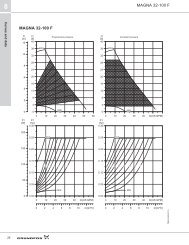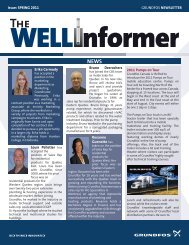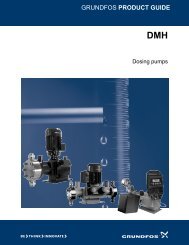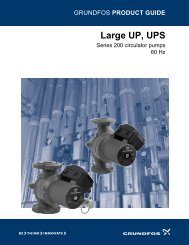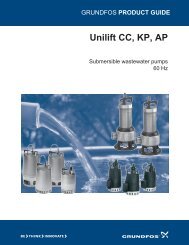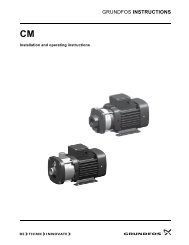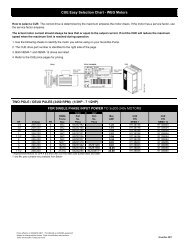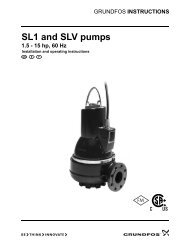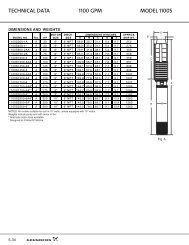Create successful ePaper yourself
Turn your PDF publications into a flip-book with our unique Google optimized e-Paper software.
10<br />
<strong>Grundfos</strong> E-<strong>pumps</strong><br />
Advanced use of MLE motors<br />
Limit exceeded 1 and 2<br />
Limit exceeded is a monitoring function monitoring one<br />
or two values/inputs. The function enables different<br />
inputs to activate various outputs and alarms/<br />
warnings when the signal input has exceeded<br />
pre-determined limits.<br />
Input<br />
Fig. 83 Example of a "limit exceeded" sequence<br />
Purpose and benefits<br />
The purpose of this function is to monitor parameters<br />
which are central for the application. This will enable<br />
the controller to react to possible, abnormal operating<br />
conditions. This makes the E-pump a more important<br />
and integrated part of a system, and it can thus replace<br />
other existing monitoring units.<br />
The liquid temperature can be monitored, and thus the<br />
E-pump can ensure that the system temperature does<br />
not exceed a maximum permissible level.<br />
The minimum inlet pressure can be monitored, and<br />
thus the E-pump can prevent damage caused by a<br />
cavitation or dry run.<br />
Applications<br />
The limit exceeded function is typically used for<br />
monitoring secondary parameters in the systems.<br />
This function is available in these pump sizes:<br />
2-pole<br />
[Hp]<br />
Limit exceeded<br />
Single-phase <strong>pumps</strong><br />
Outputs<br />
Alarm/warning<br />
4-pole<br />
[Hp]<br />
0.50 - 1.5 0.33 - 1.0<br />
- -<br />
Three-phase <strong>pumps</strong><br />
2-pole<br />
[Hp]<br />
1.0 - 10 15 - 30<br />
●<br />
●<br />
TM03 9188 3507<br />
Description<br />
The figures below show two examples of setpoint monitoring<br />
by means of the limit exceeded function.<br />
Monitored value = feedback value<br />
Limit<br />
Setpoint<br />
Action<br />
Not active<br />
Detection<br />
delay<br />
Fig. 84 Limit exceeded sequence with the limit type<br />
"max. limit", for example monitoring of bearing<br />
temperature<br />
Monitored value = feedback value<br />
Setpoint<br />
Limit<br />
Action<br />
Not active<br />
Detection<br />
delay<br />
Reset hysteresis<br />
Active<br />
Reset hysteresis<br />
Active<br />
Reset delay<br />
Reset delay<br />
Fig. 85 Limit exceeded sequence with the limit type<br />
"min. limit"<br />
When the limit is exceeded, the signal input crosses<br />
the limit as an increasing or decreasing value, and the<br />
function can be set to cover both situations.<br />
TM03 9197 3607<br />
TM03 9196 3607<br />
72



